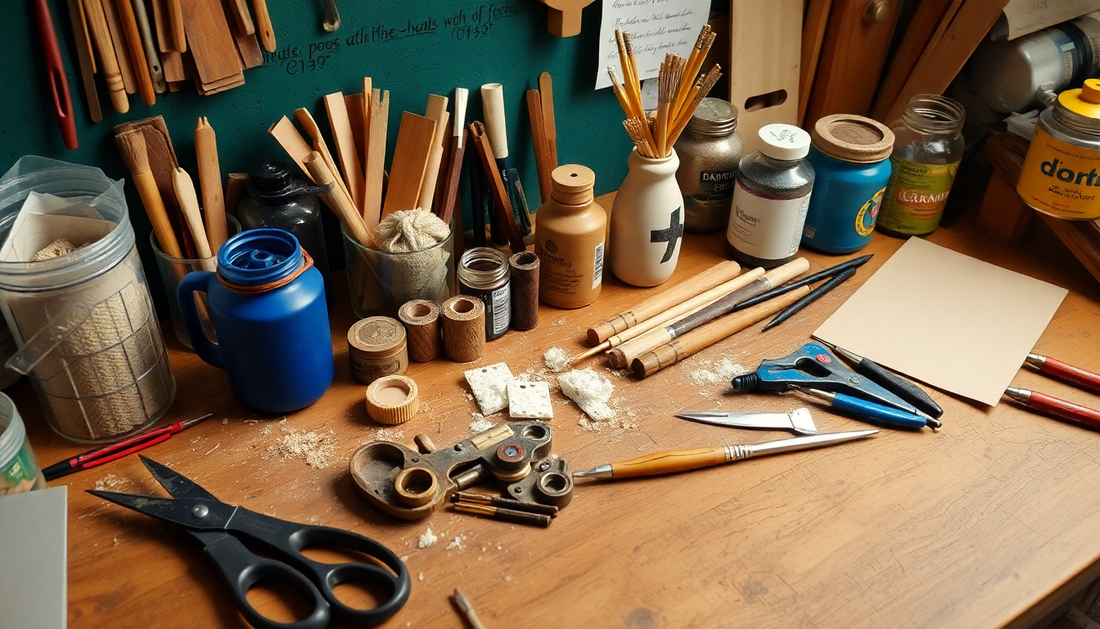
The Ultimate Handcrafting Guide: Discover Techniques, Tips, and Trends for Creating Stunning Handmade Items
Share
Introduction to Handcrafting
Handcrafting is an art that combines creativity, skill, and a personal touch. It's a fulfilling way to express yourself and create unique items that reflect your personality and style. Whether you're a seasoned artisan or just starting out, this ultimate guide will equip you with essential techniques, valuable tips, and the latest trends to create stunning handmade items that stand out.
The Benefits of Handcrafting
Engaging in handcrafting offers numerous benefits, including:
- Stress Relief: The repetitive motions and focus required can be meditative, helping to reduce anxiety and promote relaxation.
- Creativity Boost: Crafting allows you to explore your creative side, leading to innovative ideas and projects.
- Personal Connection: Handmade items carry more emotional weight than mass-produced goods, making them special gifts or keepsakes.
- Skill Development: Handcrafting enhances fine motor skills, problem-solving abilities, and patience.
- Community Engagement: Joining crafting groups or attending workshops can foster connections with like-minded individuals.
Essential Handcrafting Techniques
Mastering various handcrafting techniques can greatly enhance your abilities and allow you to create a wider range of items. Here are some essential techniques to explore:
- Embroidery: This technique involves decorating fabric with needle and thread. Start with simple stitches like backstitch, satin stitch, and French knots to create beautiful designs on clothing or home decor.
- Crocheting: Using a hook to interlock yarn, crocheting allows you to create intricate patterns and textures. Begin with basic stitches like chain, single crochet, and double crochet to make items such as blankets, hats, and scarves.
- Knitting: This method uses two needles to weave yarn into fabric. Learn the fundamental stitches—knit and purl—to create a variety of projects, from sweaters to dishcloths.
- Woodworking: Crafting with wood involves cutting, shaping, and joining pieces to create furniture or decorative items. Familiarize yourself with basic tools like saws, chisels, and sanders to start building your projects.
- Pottery: Shaping clay into functional and decorative pieces is a rewarding experience. Explore hand-building techniques or invest in a pottery wheel to create bowls, mugs, and sculptures.
- Paper Crafting: Techniques such as origami, scrapbooking, or card making can help you create beautiful paper items. Experiment with different types of paper and tools to bring your ideas to life.
Tips for Successful Handcrafting
To ensure your handcrafting journey is successful and enjoyable, consider the following tips:
- Start Small: Begin with simple projects to build your confidence and skills. A small project, like a keychain or a simple scarf, can be a great way to practice.
- Choose Quality Materials: Invest in high-quality supplies to enhance the durability and appearance of your creations. This applies to everything from yarn and fabric to tools and paint.
- Practice Regularly: Consistent practice is key to improving your crafting abilities. Set aside dedicated time each week to work on your projects.
- Seek Inspiration: Follow crafting blogs, join online communities, or visit local craft fairs for fresh ideas. Pinterest and Instagram are excellent platforms for discovering new trends and techniques.
- Document Your Progress: Keep a crafting journal to track your projects, ideas, and techniques learned. This can also serve as a portfolio of your work.
- Don’t Be Afraid to Make Mistakes: Mistakes are part of the learning process. Embrace them and use them as opportunities to grow and improve your skills.
Current Trends in Handcrafting
Staying informed about the latest trends in handcrafting can help you create items that resonate with today's market. Here are some current trends to consider:
- Sustainable Crafting: Utilizing eco-friendly materials and techniques to minimize environmental impact is becoming increasingly popular. Consider using organic fabrics, recycled materials, and natural dyes in your projects.
- Upcycling: Transforming old or discarded items into new, beautiful creations is not only environmentally friendly but also a creative challenge. Look for ways to repurpose furniture, clothing, or household goods.
- Minimalism: The minimalist movement emphasizes simple, functional designs that prioritize quality over quantity. Focus on creating items that serve a purpose while maintaining an aesthetic appeal.
- Digital Crafting: Incorporating technology into traditional crafting practices is on the rise. Tools like laser cutters, 3D printers, and digital design software can expand your creative possibilities.
- DIY Kits: The popularity of curated kits that provide all necessary materials and instructions for beginners has grown. These kits make it easier for newcomers to dive into crafting without feeling overwhelmed.
Building Your Crafting Space
Creating a dedicated crafting space can enhance your productivity and creativity. Here are some tips for setting up an inspiring workspace:
- Choose the Right Location: Find a quiet, well-lit area in your home where you can focus on your projects without distractions.
- Organize Your Supplies: Use storage bins, shelves, and pegboards to keep your materials organized and easily accessible. Label everything to save time searching for items.
- Personalize Your Space: Add personal touches, such as artwork or inspirational quotes, to create an environment that motivates you.
- Invest in Comfortable Furniture: Ensure you have a comfortable chair and table at the right height to avoid strain during long crafting sessions.
- Keep Tools Within Reach: Arrange your tools for easy access, so you can efficiently switch between different crafting techniques.
Conclusion
Handcrafting is not just a hobby; it's a meaningful way to express your creativity while producing unique items that carry personal significance. By mastering techniques, utilizing tips, and staying informed about trends, you can elevate your crafting to stunning new heights. Start your handcrafting journey today, and enjoy the satisfaction that comes from creating something truly special. Remember, the world of handcrafting is vast and full of possibilities—embrace it with open arms, and let your creativity flourish!
